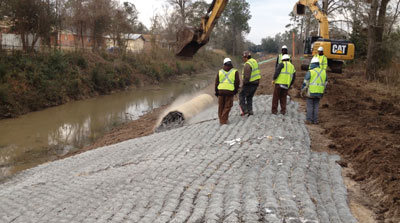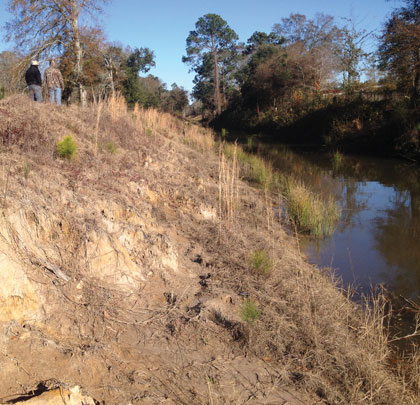Stabilizing Long Beach Canal after Hurricane Katrina
Long Beach, Mississippi, is located in Harrison County and is part of the Gulfport-Biloxi area. Hurricane Katrina struck the region on August 29, 2005, destroying more than 90 percent of the buildings along the Gulf of Mexico in Long Beach. Many residents have returned, but the recovery effort is still ongoing.
The Mississippi Coastal Improvements Program of the United States Army Corps of Engineers Mobile District Office headed the Upper Channel Improvements (Phase IV), in Harrison County, Mississippi. The upper channel of the Long Beach Canal was clogged with trees and overgrown vegetation. The overgrowth decreased water flow traveling through the channel. Maintenance was limited for several years after the effect of Hurricane Katrina. When the vegetation was finally cleared, damage to the slope from debris removal quickly accelerated erosion on the unprotected slopes. Although the channel was now opened to handle storm water flow, it soon became apparent that permanent erosion control was necessary.
STABILIZING MEASURES
The USACE released a contract to install stabilizing measures along the north bank for approximately 2,000 linear feet of the upper channel of the Long Beach Canal. The stabilization included preparation of the side slopes, soil amendments, seeding, turf reinforcement, erosion control mattresses, gabion mattresses, and rock riprap.
This included 46,000 square feet of erosion control mattresses, with 36,000 square feet of turf reinforcement matting as the underlayment with a seed mix on 230 cubic yards of top soil layer.
The depth of the canal channel ranges from 12 to 15 feet and the side slopes range from 3H:1V to 2.5H:1V. The designer chose Flexamat® on slopes that would experience deep flows and high velocity from future storm events. Choosing a product that would provide a decreased Manning’s “n” value, but also provide protection during maintenance (mowing) was very important to the performance of these canals to relieve flooding occurrences.
The general contractor awarded the work was Tropical World Landscaping. They were responsible for obtaining the Nation Pollutant Discharge Elimination System (NPDES) permit, and also preparing the Storm Water Pollution Prevention Plan (SWPPP) to outline the methods with which the contractor will control runoff using Best Management Practices (BMPs).
Southern Pipe & Supply was the distributor on the project. They worked with the USACE along with Flexamat manufacturer, Motz Enterprises, on the design of the project. Once the contractor was named, SPS and Motz continued to provide support in the execution and installation of the contract.
PREP AND INSTALLATION
 Prior to installing the Flexamat, the subcontractor, Carcel & G, prepared the subgrade as detailed on the construction drawings. The area was cleared of rocks and debris sized 3 inches or larger. The Turf Reinforcement Mat (TRM) was placed directly on the prepared subgrade. To insure the proper surface contact with the TRM and the subgrade, 1 to 2 inches of approved top soil was applied to the top of the TRM and seeded, then fertilized as detailed. Since this was installed during winter, a cool season seed mix was selected using 50 pounds per acre (98 percent pure live seed) of Perennial Rye seeded within 24 hours of slope preparation. They sowed one-half the seed in one direction, and sowed the remainder at a right angle to the first sowing. Covering the seed uniformly to a maximum depth of ¼ inch in clay soils was recommended. Incorporated into the top soil was a granular fertilizer (13-13-13) at rates of 460 pounds per acre and pH adjuster (Lime) at rates of 4000 pounds per acre.
Prior to installing the Flexamat, the subcontractor, Carcel & G, prepared the subgrade as detailed on the construction drawings. The area was cleared of rocks and debris sized 3 inches or larger. The Turf Reinforcement Mat (TRM) was placed directly on the prepared subgrade. To insure the proper surface contact with the TRM and the subgrade, 1 to 2 inches of approved top soil was applied to the top of the TRM and seeded, then fertilized as detailed. Since this was installed during winter, a cool season seed mix was selected using 50 pounds per acre (98 percent pure live seed) of Perennial Rye seeded within 24 hours of slope preparation. They sowed one-half the seed in one direction, and sowed the remainder at a right angle to the first sowing. Covering the seed uniformly to a maximum depth of ¼ inch in clay soils was recommended. Incorporated into the top soil was a granular fertilizer (13-13-13) at rates of 460 pounds per acre and pH adjuster (Lime) at rates of 4000 pounds per acre.
Flexamat rolls (16 feet by 32 feet) were installed on the slope. Starting at the crown of slope with a termination trench, the rolls were unrolled down the slope using an excavator and help from gravity. The Flexamat erosion control mattresses were designed to extend 4 feet below the low water elevation. The 16-foot panels of the erosion control mattress were abutted next to another. Flexamat was placed on the majority of the 2,000 feet of the north bank and received end treatment with riprap (ALDOT Class II). One section of the bank was treated with gabion mattress filled with gabion stone. The installation of the Flexamat was much faster in comparison to the gabion mattress area.
FINISHED PROJECT
This project was initially estimated to be a 3 to 4 month project. The efficiency of the Flexamat rolls being installed enabled the entire project to be completed within 30 days. During an on-site meeting with the general and subcontractor prior to the start of the project, Barry Smith, who heads up Flexamat for Southern Pipe and Supply, stated “You guys will be finished within 3 weeks.” The sub said after the project, “Had we used Flexamat on the entire slope, we would have been finished in 2 weeks.”
Three months after installation, grass is already growing through the matting. The Flexamat blocks have a low 2.25-inch profile, allowing the mowing of the channel when necessary. The Flexamat armor was free of debris. The subcontractor stated, “It’s interesting to identify which products catch debris. The rock riprap and the wire mesh of the gabion baskets are immediately filling with sticks and leaves.”
The Flexamat erosion control matting will provide permanent armor for this upper portion of the Long Beach Canal, providing vital flood relief for the next hurricane that will inevitably strike the region.
■ ■ ■
[divider]
About The Authors John Slupecki, CPESC, is the southeast territory manager for Motz Enterprises, Inc. Matt Motz is vice president of Motz Enterprises, Inc. For more information, call 513.772.6689, or visit www.flexamat.com.
Modern Contractor Solutions, July 2014
Did you enjoy this article?
Subscribe to the FREE Digital Edition of Modern Contractor Solutions Magazine!


